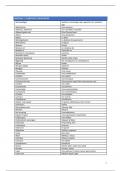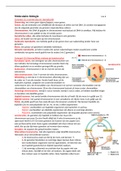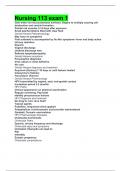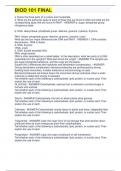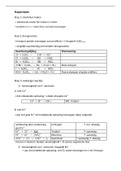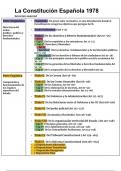CLA1101[A] Greek Civilization
Week 1: Early Greece – Due September 18th
Course Introduction
CLA 1101 Introduction
Lesson 1: The Stone Age
Who Were the Greeks?
Timeline
The Mediterranean
- Greece is in the Mediterranean
- It consists of a mainland, a large peninsula, and a collection of islands
- Referred to the Islands of the Sea by others like Egypt
- Greece is sphered between Samiran and Egypt
Greece (Hellas to the Greeks)
- For most of its history, Greece was not a unified country
- So, what did it mean to be “Greek”?
o Did not refer themselves as Greek, but as Athenians or Spartans
o The Romans called them Graeci – Greeks
o Hellas – Mythical Founder
When you Think of Greece
- Athens
- Philosophy
, - Literature
Unified by Language
- Foreigners were called Barbarians as they did not speak Greek
Ancient Greek Dialects
- Different letter forms and pronunciations, but all are essentially Greek
Unified in Beliefs
- Different versions of myths, but many gods and heroes in common
- Everyone knew Homer and Hesiod
The Paleolithic Period
From the Beginning
Hesiod’s Ages of Humanity
Gold – Silver – Bronze – Heroes (Bronze Age) – Iron
Divisions of the Prehistoric Past
Chronology of the Stone Age (According to Jeremy Rutter)
- Paleolithic (c. 20,000 – 8,300 BCE) – making tools out of stone
- Mesolithic (c. 8,300 – 6,00 BCE) – transition period
- Early Neolithic (c. 6,000 – 5,000 BCE) – start farming
- Middle Neolithic (c. 5,000 – 4,500 BCE) – transition of tools
, - Late Neolithic (c. 4,500 – 4,000 BCE) – transition of tools to copper/bronze
- Final Neolithic (Chalcolithic) (c. 4,000 – 3,000 BCE) – copper stone age
- *Note: There is no agreement with the calendar dates until the historic period
Modern Humans (Homo Sapiens) Appear in Greece c. 38,000 Years Ago
Franchthi Cave (38,000 – 3000 BCE)
- This cave is in use throughout the Stone Age and gives us a view of changes in subsistence over
time
- Abandoned due to rising sea levels
Palaeolithic Greece c. 38,000 – 8,300 BCE
- The people were nomadic hunters and gatherers
- No evidence of inhabitation of the cave in winter
Palaeolithic Tools
- Tools are generally large spear points, scrapers, and blades
- Flint Knapping
The Mesolithic Period c. 8,300 – 6,000 BCE
- The warmer, wetter climate meant that Greece was covered in forests
New Fauna
- Elk, Deer, Wild Boar
- Greece was forested, so now there are forest animals to hunt
Costal Changes
- The Cycladic Islands were born as the water rose
Dietary Changes Result from New Foods Available
- Forest animals are hunted
- Fish and seafood appear in diet – deep sea fish
- Barley, lentils, nuts – being crushed using stones (quern)
- Food is being processed before eating
New Tools – Microliths (Small Stone)
- Gradual change
- Smaller blades and points
- Retouching creating sharp edges
- Both sides of these tools
Evidence of Sea Faring
- Deep sea fish
- Andesite quern from Aegina
Week 1: Early Greece – Due September 18th
Course Introduction
CLA 1101 Introduction
Lesson 1: The Stone Age
Who Were the Greeks?
Timeline
The Mediterranean
- Greece is in the Mediterranean
- It consists of a mainland, a large peninsula, and a collection of islands
- Referred to the Islands of the Sea by others like Egypt
- Greece is sphered between Samiran and Egypt
Greece (Hellas to the Greeks)
- For most of its history, Greece was not a unified country
- So, what did it mean to be “Greek”?
o Did not refer themselves as Greek, but as Athenians or Spartans
o The Romans called them Graeci – Greeks
o Hellas – Mythical Founder
When you Think of Greece
- Athens
- Philosophy
, - Literature
Unified by Language
- Foreigners were called Barbarians as they did not speak Greek
Ancient Greek Dialects
- Different letter forms and pronunciations, but all are essentially Greek
Unified in Beliefs
- Different versions of myths, but many gods and heroes in common
- Everyone knew Homer and Hesiod
The Paleolithic Period
From the Beginning
Hesiod’s Ages of Humanity
Gold – Silver – Bronze – Heroes (Bronze Age) – Iron
Divisions of the Prehistoric Past
Chronology of the Stone Age (According to Jeremy Rutter)
- Paleolithic (c. 20,000 – 8,300 BCE) – making tools out of stone
- Mesolithic (c. 8,300 – 6,00 BCE) – transition period
- Early Neolithic (c. 6,000 – 5,000 BCE) – start farming
- Middle Neolithic (c. 5,000 – 4,500 BCE) – transition of tools
, - Late Neolithic (c. 4,500 – 4,000 BCE) – transition of tools to copper/bronze
- Final Neolithic (Chalcolithic) (c. 4,000 – 3,000 BCE) – copper stone age
- *Note: There is no agreement with the calendar dates until the historic period
Modern Humans (Homo Sapiens) Appear in Greece c. 38,000 Years Ago
Franchthi Cave (38,000 – 3000 BCE)
- This cave is in use throughout the Stone Age and gives us a view of changes in subsistence over
time
- Abandoned due to rising sea levels
Palaeolithic Greece c. 38,000 – 8,300 BCE
- The people were nomadic hunters and gatherers
- No evidence of inhabitation of the cave in winter
Palaeolithic Tools
- Tools are generally large spear points, scrapers, and blades
- Flint Knapping
The Mesolithic Period c. 8,300 – 6,000 BCE
- The warmer, wetter climate meant that Greece was covered in forests
New Fauna
- Elk, Deer, Wild Boar
- Greece was forested, so now there are forest animals to hunt
Costal Changes
- The Cycladic Islands were born as the water rose
Dietary Changes Result from New Foods Available
- Forest animals are hunted
- Fish and seafood appear in diet – deep sea fish
- Barley, lentils, nuts – being crushed using stones (quern)
- Food is being processed before eating
New Tools – Microliths (Small Stone)
- Gradual change
- Smaller blades and points
- Retouching creating sharp edges
- Both sides of these tools
Evidence of Sea Faring
- Deep sea fish
- Andesite quern from Aegina



